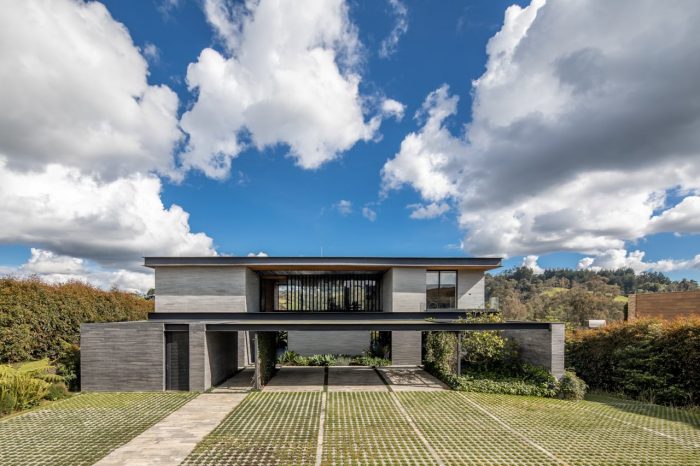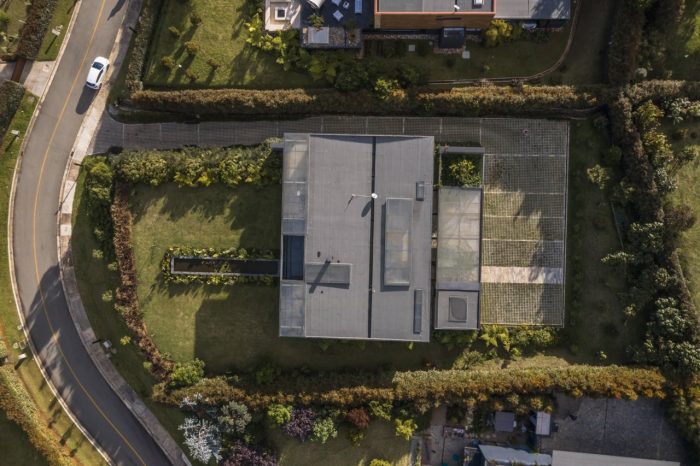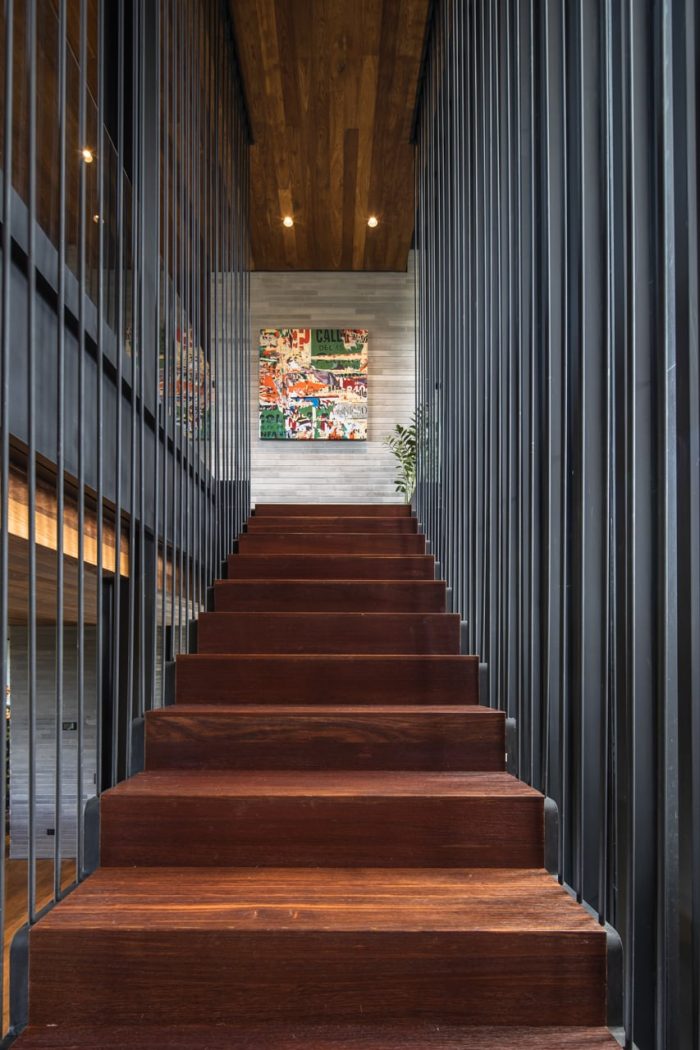在山顶上,房子与由山坡、平原、水和当地植被组成的自然景观融为一体。视觉效果是面向远处的景观,由山脉和周围的自然景观组成。
At the top of a hill, the house integrates with a natural landscape made up of slopes, plains, water and local vegetation. The visuals are oriented toward the distant landscape, made up of mountains and the surrounding nature.
它是一组安排在地面上的固体元素,支撑着上面的水平元素。这种对比的语言–在满和空、自然和干预、固体和透明之间–配置了一个由空隙、家庭用途和垂直与水平之间的关系所衔接的体积感。
It is a set of solid elements arranged on the ground, which support the upper horizontal elements. This language of contrast – between the full and the empty, the natural and the intervened, the solid and the transparencies – configures a volumetry articulated by the voids, by the domestic uses, and by the relationship between the vertical and the horizontal.
在到达房子之前,一连串的门槛和天井构成了道路的第一个步骤。抵达的空间通过阴影和开放的和有盖的外部空间过滤,是向内部的过渡。进入室内空间意味着要经过自然和建筑的过渡,让人在走过自然和室外空间时发现房子的内部。入口大厅墙后的天井伴随着人们进入室内。进入房子意味着通过一个开放的平面图重新发现外部,社交区的活动将自然和室内空间与伴随着房子建筑的景观结合起来。
A succession of thresholds and patios before reaching the house make up the first steps of the path. The arrival space filters through shadows and open and covered exterior spaces, a transition to the interior. Accessing the interior space means going through natural and built transitions that allow one to discover the interior of the house while walking through nature and outdoor spaces. A patio behind the entrance hall wall accompanies the arrival inside. Entering the house means rediscovering the exterior through an open floor plan, where the activities of the social area integrate nature and the interior space with the landscape that accompanies the architecture of the house.
进入房子的第一步就发现了一个开放的平面图,在这里社会活动与厨房融为一体。在东部和西部,私人空间,如服务、卧室和书房,是由作为房屋支撑的墙壁和体量构成的。一个有盖的露台和一条延伸到地面的水巷是内部社交区域向外部的延伸。
The first steps inside the house find an open floor plan where social activities are integrated with the kitchen. To the east and west, private spaces such as services, bedrooms and the study, are made up of the walls and volumes that serve as a support for the house. A covered terrace and a water lane that extends over the ground are the extension of the interior social area to the exterior.
一个位于入口立面的楼梯,安排在外部花园旁边,整合了第一层和第二层。在到达的地方,它与一个集体的家庭空间相衔接,反过来将儿童房和主卧室分开。第一层的一系列空隙形成了内部空间的双重高度,并确定了停留在墙壁上的水平平面和构成私人空间的体积的轻盈性。
A staircase located on the access façade and arranged next to the exterior garden integrates the first and second levels. In the place of arrival, it is articulated with a collective family space that – in turn – separates the children’s rooms from the main bedroom. A succession of voids on the first level forms double heights in the interior space and defines the lightness of the horizontal planes that rest on the walls and the volumes that make up the private spaces.
卧室位于第二层,占据了东面和西面的立面,北面和南面都有景观的视觉效果。卧室有通往外部阳台的出口,这些阳台配置了水平的平面,并停留在第一层的墙壁和体量上。
The bedrooms are located on the second level, occupying the eastern and western façades, with visuals of the landscape located to the north and to the south. The bedrooms have exits to exterior balconies that configure the horizontal planes and that rest on the walls and volumes of the first level.
这座房子在形式上是一个饱满和空虚的对比,是与它的物质性相关的轻盈和坚固。界定结构稳固性的实体是覆盖着深灰色和浅灰色混凝土块的砖石墙。结构的轻盈性是金属夹层,它构成了语言,并补充了物质性与外部的对比。在内部,地板、天花板和天然木材包层配置了一个温暖的生活空间,在这里,家庭用途伴随着自然元素,覆盖了房屋的水平和垂直平面。在室外,当地的自然作为景观,将植被、水和视觉效果与房屋的材料、颜色和用途结合起来。
The house is a formal contrast of full and empty, of lightness and firmness associated with its materiality. The solids, which define the solidity of the structure, are masonry walls covered with pieces of dark and light grey concrete. The lightness of the structure is the metal mezzanines that make up the language and complement the contrast of the materiality to the outside. Inside, floors, ceilings and natural wood cladding configure a warm living space, where domestic uses are accompanied by natural elements that cover the horizontal and vertical planes of the house. Outside, local nature serves as a landscape that integrates vegetation, water and visuals with the materiality, colors and uses of the house.
Architects: Alejandro Restrepo-Montoya Arquitectura, Estudio Central
Area : 480 m²
Year : 2020
Photographs :Alejandro Arango, Luis Bernardo Cano
Manufacturers : Acquavieira, Concrestone
Lead Architect : Alejandro Restrepo-Montoya, María Posada, Lina María Upegui, Diana Valencia, Juliana Zapata
Construction : AGS Arquitectos / Alexander Garzón Sánchez
Landscape : Nicolás Hermelín
Structural Design : Jorge Eduardo Arbeláez Rojas
Lighting : High Lights
City : Envigado
Country : Colombia























